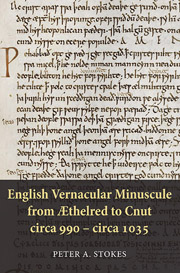Book contents
- Frontmatter
- Contents
- Lists of Tables
- Lists of Figures
- Lists of Plates
- Acknowledgements
- List of Abbreviations
- Introduction
- 1 Background
- 2 Attributions of Origin
- 3 Scribal Change in Bookhands and Charters: The ‘Tall and Narrow’ Hands
- 4 Scribal Continuity in Bookhands and Charters: The ‘Square-Influenced’ Hands
- 5 Glosses and Scribbles
- Conclusion: Change and Continuity in Early English Vernacular Minuscule
- Appendix. List of Scribal Hands
- Glossary
- Bibliography
- Index of Manuscripts and Charters
- General Index
- Plate section
3 - Scribal Change in Bookhands and Charters: The ‘Tall and Narrow’ Hands
Published online by Cambridge University Press: 05 April 2014
- Frontmatter
- Contents
- Lists of Tables
- Lists of Figures
- Lists of Plates
- Acknowledgements
- List of Abbreviations
- Introduction
- 1 Background
- 2 Attributions of Origin
- 3 Scribal Change in Bookhands and Charters: The ‘Tall and Narrow’ Hands
- 4 Scribal Continuity in Bookhands and Charters: The ‘Square-Influenced’ Hands
- 5 Glosses and Scribbles
- Conclusion: Change and Continuity in Early English Vernacular Minuscule
- Appendix. List of Scribal Hands
- Glossary
- Bibliography
- Index of Manuscripts and Charters
- General Index
- Plate section
Summary
Now that the corpus of scribal hands has been described and, as far as possible, dated and localised on non-palaeographical grounds, we can turn finally to the script. As has already been discusssed, the development of script to the end of the tenth century and the beginning of the eleventh is one of the end of Square minuscule and the introduction of a new script, English Vernacular minuscule. This change seems to have begun in the early 990s, and its most prominent feature is the lengthening and narrowing of letters, with ascenders and descenders in particular becoming significantly longer than in Square minuscule. Dumville has proposed two strands of scribal practice in English Vernacular minuscule, however: the first of these shows the new proportions and also retains few letter-forms from Square minuscule, but the second tends to preserve more of the tenth-century script, including sometimes its proportions but more often the characteristic letter-forms such as flat-topped a. The purpose of this chapter is therefore to examine the first style in more detail, a style characterised by tall and narrow proportions and the rejection of tenth-century letter-forms, and which is here called Style-I English Vernacular minuscule.
Winchester
Winchester Cathedral (Old Minster)
Before considering the Vernacular minuscule which was written at Winchester in the eleventh century, it is worth asking what vernacular script was written in the late tenth century, particularly during Æthelwold's episcopacy (963– 85).
- Type
- Chapter
- Information
- Publisher: Boydell & BrewerPrint publication year: 2014



